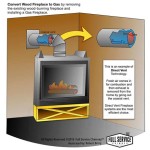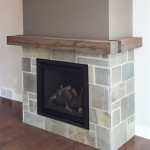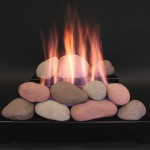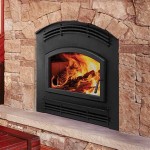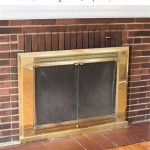Cast Stone Fireplaces: Aesthetics, Durability, and Design Considerations
Cast stone fireplaces represent a sophisticated and enduring option for homeowners seeking to enhance their living spaces. This engineered material offers a compelling alternative to natural stone, combining aesthetic versatility with remarkable durability. Understanding the properties, benefits, and design considerations associated with cast stone is crucial for making an informed decision when selecting a fireplace.
Cast stone, also known as artificial stone, is a composite material manufactured to resemble natural quarried stone. It is created by mixing cement, aggregates (such as sand, gravel, or crushed stone), mineral pigments for coloring, and various additives to enhance its properties. This mixture is then poured into molds of varying shapes and sizes, allowed to cure, and finished to achieve the desired texture and appearance. The result is a material that is structurally sound, visually appealing, and significantly more cost-effective than natural stone.
The appeal of cast stone fireplaces lies in their ability to replicate the look and feel of expensive natural stone, such as limestone, travertine, or sandstone, without the associated high cost and installation complexities. This makes it a popular choice for both residential and commercial applications, offering a range of design possibilities that can complement various architectural styles.
Aesthetics and Design Versatility
One of the primary advantages of cast stone fireplaces is their exceptional aesthetic versatility. The manufacturing process allows for intricate detailing and customization to match specific design requirements. Molds can be created to replicate historical designs, modern minimalist styles, or completely bespoke creations. The wide range of available colors and textures further enhances the design possibilities, allowing homeowners to achieve the precise look they desire.
The ability to mold cast stone into accurate replicas of natural stone features, such as keystones, mantels, surrounds, and hearths, allows for the creation of fireplaces that exude elegance and sophistication. Intricate carvings, relief work, and other decorative elements can be easily incorporated into the design, adding character and visual interest to the fireplace. The uniform consistency of cast stone also ensures that the color and texture remain consistent throughout the fireplace, providing a seamless and cohesive aesthetic.
Beyond replicating existing stone patterns, cast stone can also be used to create entirely new and innovative designs. Architects and designers can experiment with different shapes, textures, and finishes to create fireplaces that are truly unique and reflective of their personal vision. The flexibility of the material allows for the integration of modern design elements, such as clean lines, geometric shapes, and recessed lighting, to create contemporary fireplaces that complement modern interiors.
Color matching is a significant advantage of cast stone. Pigments are added to the mix during the manufacturing process, ensuring even color distribution throughout the material. This eliminates the variations in color that are often found in natural stone, providing a more consistent and predictable aesthetic outcome. Homeowners can choose from a wide spectrum of colors, ranging from warm earth tones to cool grays and whites, to create a fireplace that perfectly complements their existing décor.
Durability and Performance Characteristics
Durability is a key factor that contributes to the longevity and appeal of cast stone fireplaces. The engineered composition of the material makes it highly resistant to weathering, erosion, and other forms of environmental damage. Unlike some natural stones that can be susceptible to cracking or staining, cast stone is designed to withstand the test of time, maintaining its aesthetic appeal for many years with minimal maintenance.
The strength and density of cast stone also make it an excellent material for fireplaces that are exposed to high temperatures. While it is not fireproof in the truest sense of the word, it is highly heat-resistant and can withstand the radiant heat generated by a fireplace without cracking or deteriorating. This is particularly important for fireplaces that are used frequently or for extended periods.
Furthermore, cast stone is less porous than many natural stones, which makes it more resistant to staining and water damage. This is especially beneficial for fireplaces that are located in areas with high humidity or that are prone to spills. The low porosity also makes it easier to clean and maintain, requiring only simple cleaning solutions and minimal effort to keep it looking its best.
The structural integrity of cast stone is also superior to that of some natural stones. The manufacturing process allows for precise control over the composition and density of the material, resulting in a product that is consistently strong and durable. This reduces the risk of cracking, chipping, or other forms of damage that can occur with natural stone, particularly during installation or transportation.
Properly installed cast stone fireplaces require minimal maintenance. Regular cleaning with a mild detergent and water is typically sufficient to keep the surface looking clean and free of debris. In some cases, a sealant may be applied to further protect the surface from staining and water damage. However, unlike natural stone, cast stone does not typically require specialized cleaning products or treatments.
Installation Considerations and Cost-Effectiveness
The installation of a cast stone fireplace requires careful planning and execution to ensure a safe and aesthetically pleasing result. While the material is generally lighter and easier to handle than natural stone, it is still heavy and requires proper structural support. It is recommended to consult with a qualified contractor or installer who has experience working with cast stone to ensure that the installation is done correctly.
Before installation, it is important to prepare the area where the fireplace will be located. This may involve reinforcing the floor to support the weight of the fireplace, running gas or electrical lines, and ensuring that the chimney or flue is properly vented. It is also important to check local building codes and regulations to ensure that the installation complies with all applicable requirements.
The installation process typically involves assembling the various components of the fireplace, such as the mantel, surround, and hearth, using mortar or adhesive. The joints between the components should be carefully sealed to prevent water damage and to create a seamless appearance. It is also important to ensure that the fireplace is properly aligned and leveled to prevent any structural problems in the future.
One of the major advantages of cast stone fireplaces is their cost-effectiveness compared to natural stone. The manufacturing process is less labor-intensive and produces less waste than quarrying and transporting natural stone. This translates into lower material costs and reduced installation expenses. Homeowners can achieve the look and feel of a high-end stone fireplace without breaking the bank.
The long-term cost benefits of cast stone fireplaces also extend to maintenance and repairs. The durability and low maintenance requirements of the material mean that homeowners can save money on cleaning, sealing, and repairs over the lifespan of the fireplace. This makes cast stone a cost-effective and sustainable choice for homeowners who are looking for a long-lasting and aesthetically pleasing fireplace solution.
While the initial investment in a cast stone fireplace may be higher than some other options, such as prefabricated metal fireplaces, the long-term value and aesthetic appeal of the material make it a worthwhile investment for homeowners who are looking to enhance the value and beauty of their homes. The ability to customize the design and choose from a wide range of colors and textures also allows homeowners to create a fireplace that is truly unique and reflective of their personal style.

Cast Stone Fireplaces So Much Better With Age

Newport Cast Stone Fireplace Surround Oregon Castings And Design

Conrad Cast Stone Fireplace Mantel Old World Stoneworks

Verona Cast Stone Fireplace Surround Surrounds

Modern Cast Stone Fireplace Singapore

Cast Stone Fireplaces Installation And Warranty Included

Amhurst Cast Stone Fireplace Mantels Old World Stoneworks

Colors And Finishes Cast Fire Places

Cast Stone Fireplaces Traditional Living Room Houston By Precision Development Inc Houzz

Diy Faux Cast Stone Fireplace Part 2 Building The Mantel Top Shelf

